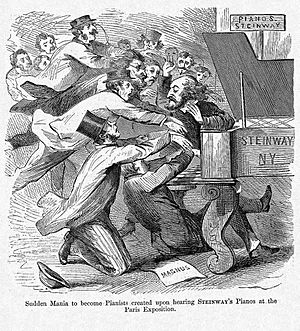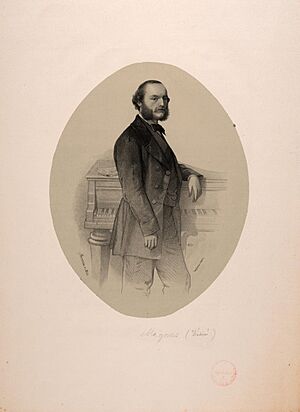Désiré Magnus facts for kids
Désiré Magnus (born Magnus Deutz) was a talented Belgian concert pianist, teacher, and composer. He was born on June 13, 1828, and passed away on December 17, 1883. He often published his music using the name D. Magnus.
About Désiré Magnus
His Life and Music
Désiré Magnus was born in Brussels, the capital of Belgium. He started learning piano at a young age. He studied with Georg Jacob Vollweiler in Heidelberg, Germany. He also attended the Brussels Conservatory, a famous music school. In 1843, he won the First Prize there, showing how skilled he was.
After finishing his studies, Magnus went on many successful concert tours. He performed in England, Germany, Russia, Spain, and other countries. People loved to hear him play the piano. Later, he decided to live in Paris, France. There, he became well-known as a pianist, a teacher, a composer, and even a music critic. This means he also wrote reviews about other musicians' performances.
In 1867, there was a big event in Paris called the Exposition Universelle. It was like a world fair where new inventions and art were shown. Désiré Magnus played a special Steinway concert-grand piano at this event. His performance was so impressive that it inspired a famous drawing (a lithograph) by Amédée de Noé.
Désiré Magnus lived in Paris until he passed away on December 17, 1883.
What Music Did He Write?
Désiré Magnus wrote many different kinds of music. He composed for opera, which is a play where the story is sung. He also wrote chamber music, which is for a small group of instruments, like a violin and piano playing together. He wrote songs for singers too.
He was especially known for his piano music. He wrote many pieces for solo piano, which means just one person playing the piano. These pieces often had beautiful melodies and were sometimes very fast and exciting.
Magnus also created music to help people learn how to play the piano. These are called pedagogical works. They are like musical exercises and lessons.
- La Tolédane (1874) – This was an opera he composed.
- Les Pleurs de la jeune fille (1852) – A piece for violin and piano, also written for piano alone.
- Duo sur des motifs de l'opéra "Paul et Virginie" (1877) – A duet for violin and piano, written with another famous musician, Henri Vieuxtemps.
- O povero garzon! (1874) – A Venetian boat song.
- Sur l'océan (1878) – A song about the ocean.
- Judas, Chant biblique (1881) – A song based on a biblical story.
- 24 Études mélodiques et de vélocité (1876) – These are 24 studies or exercises for piano. They help pianists practice different finger movements and speeds.
- Méthode élémentaire de piano (1879) – This was a basic method book for learning piano.

This drawing by Amédée de Noé shows how popular the Steinway piano became after Désiré Magnus played it at the 1867 World's Fair in Paris.
Désiré Magnus wrote many, many pieces for solo piano. Some of his well-known piano works include:
- La Danse des ésprits (1851) – A lively caprice.
- Saltarelle (1853) – A fast, energetic dance piece.
- Steeple-Chase, Grand galop de bravoure (1859) – A very fast and brave gallop.
- Marche funèbre (1860) – A funeral march.
- La Tarabouka, Caprice moresque (1862) – A piece with a North African feel.
- L'Addio, Grande valse (1867) – A grand waltz.
- Grande sonate en ut mineur (1868) – A large-scale piano piece.
- Aïda, opéra de G. Verdi, Réminiscences et paraphrase (1873) – A piece based on famous tunes from Verdi's opera Aida.
- 24 Études de genre dans le style moderne (1875) – More studies for piano in a modern style.
- Six Sonatinas (1876) – Shorter, simpler sonatas for piano.
- À la mémoire de Beethoven, Hymne funèbre (1879) – A sad hymn in memory of the famous composer Beethoven.
- Dors bébé, Berceuse (1882) – A lullaby.


